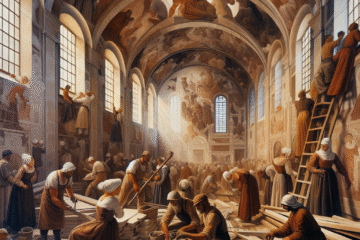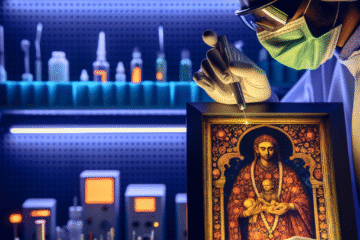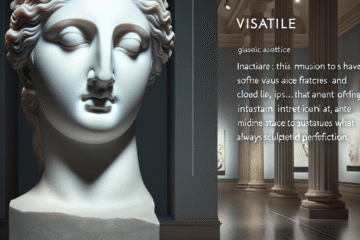Introduction: A Shadow Falls Across the Renaissance
When Michelangelo Merisi da Caravaggio stormed onto the art scene in late 16th-century Rome, he didn’t just add to the ongoing artistic conversation—he upended it. In an era marked by the refined grace of Mannerism and the lingering ideals of Renaissance classicism, Caravaggio painted saints as earthy peasants, gave villains the dignity of Greek gods, and bathed his canvases in unrelenting, theatrical light. His work spawned both admiration and scandal, igniting what would later be defined as the Baroque. Caravaggio was not simply a painter—he was a revolutionary who painted with both brush and dagger, transforming the visual language of Europe for centuries to come.
Chapter 1: The Twilight of the Renaissance
By the time Caravaggio arrived in Rome in the early 1590s, the High Renaissance had already given way to Mannerism, a style characterized by elongated figures, artificial poses, and intellectual complexity. This evolution reflected the shifts in society—religious upheaval following the Reformation, the expansion of global exploration, and the emergence of new philosophical ideas centering on individualism and skepticism.
Yet many artists worked within the inherited structures of harmony and ideal beauty. The human form remained central, but it often seemed aloof or inaccessible. Caravaggio’s raw sensibility and visceral realism would soon break through this polished surface, offering a new aesthetic grounded in emotional immediacy and spiritual drama.
Chapter 2: The Rise of a Renegade
Born in 1571 near Milan, Caravaggio trained in the studio of Simone Peterzano, who linked him indirectly to the legacy of Titian and the Venetian colorists. But Rome would be his crucible, where talent met turbulence. Living in a city teeming with churches, cardinals, and a theatrical sense of public life, Caravaggio absorbed the dramatic contrast between sacred ritual and earthly excess.
His early works—still lifes and genre scenes like “Boy with a Basket of Fruit” and “The Fortune Teller”—already demonstrated an obsession with naturalistic detail and psychological nuance. But it was in religious commissions like “The Calling of Saint Matthew” and “The Martyrdom of Saint Matthew” that he fully emerged as a revolutionary force. Here, divine light didn’t float from heaven—it slashed across the canvas, picking saints and sinners from gritty tavern interiors and dirty backstreets.
Chapter 3: Chiaroscuro and the Theater of Salvation
Caravaggio’s signature technique, chiaroscuro—the dramatic contrast of light and dark—was not his invention, but he wielded it with unprecedented narrative power. While artists like Leonardo da Vinci and Rembrandt explored subtle shading to build forms, Caravaggio weaponized the shadow. His lighting was not gentle; it was confrontational. It forced the viewer into emotional complicity with the scene.
In works like “The Conversion of Saint Paul” or “The Entombment of Christ,” light becomes a divine actor as essential as the figures themselves. Caravaggio’s illumination wasn’t merely technical—it had theological implications. At a time when the Catholic Church was asserting its authority in the Counter-Reformation, his paintings offered a new visual theology: personal, immediate, and visceral. His art preached through sensation, not sermon.
Chapter 4: The Baroque Unleashed
Caravaggio’s influence spread quickly and controversially. He was both celebrated and condemned, his life as tempestuous as his art. He was known to brawl in the streets, frequently in trouble with the law, and even convicted of murder in 1606, leading to a flight across southern Italy in exile. Still, his artistic impact persisted. Followers known as the Caravaggisti emerged across Europe—from Artemisia Gentileschi in Italy to Georges de La Tour in France and even artists in the Spanish Golden Age like Jusepe de Ribera.
The Baroque style, as it developed, absorbed Caravaggio’s radical realism and dramatized spirituality. But others also added lyricism or more polished refinement—Bernini in sculpture, Rubens in painting. What began as Caravaggio’s stark theatricality evolved into a pan-European movement that celebrated emotion, sensation, and the dazzling interplay between the sacred and the profane.
Chapter 5: Legacy in the Light
Caravaggio died in 1610 under mysterious circumstances—perhaps malaria, perhaps assassination—but his shadow only grew with time. Long overlooked for more polished contemporaries, his name was resurrected in the 20th century by art historians and critics who saw in him a precursor to modern sensibilities. His rejection of idealism, attention to the margins of society, and psychological depth resonate today in contemporary photography, cinema, and even virtual reality design, where lighting tells story as much as action.
Philosophically, Caravaggio anticipated existentialism: he painted humans struggling with faith, mortality, and redemption, often at the knife’s edge of decision. Technologically, his deep shadows and spotlighted forms mirror our current fascination with high-contrast digital imagery and design minimalism. His art, rooted in the dust of Roman streets, continues to illuminate the dark corners of the human experience.
Conclusion: A Painter of Paradoxes
Caravaggio was a rebel—not against art, but for it. He rebelled against artifice in favor of truth, against perfection in favor of presence. His paintings don’t offer easy messages or sanitized visions. They confront, challenge, and rupture expectations. In doing so, they gave birth to Baroque art’s emotional power and paved the way for centuries of artists wrestling with the divine and the deeply human. In Caravaggio’s shadow, light was reborn—not as halo or glow, but as revelation.


